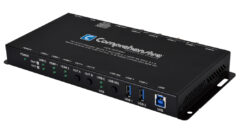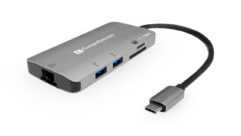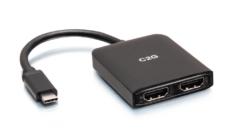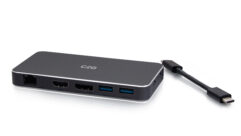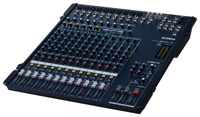

Review: Yamaha MG166C-USB
Nov 30, 2010 12:10 PM,
By John McJunkin
A mixer with powerful PC connectivity.
Yamaha MG166C-USB
It is highly advantageous for a contractor or AV firm to have the capacity to offer nearly immediate upload of conference, tradeshow, or private business meeting recordings to the Internet. Many of the mechanisms that exist to facilitate this type of service involve multiple transfers between devices, sometimes even time-consuming realtime transfers. Aside from the increased labor overhead, clunky means for getting a client’s audio online can also cost a contract when the competitor has a slick, lightning-fast way of accomplishing the same goal. For that matter, the organization that offers good and fast—not just good—can justifiably raise the fair market price for the service, hence increasing profits. Even if immediate upload is not necessary or desired, there’s simply no point in incurring additional labor overhead and unnecessarily slowing the process.
Yamaha offers its MG166C-USB mixer as a useful tool for mixing sound in a live PA or AV scenario, but it brings one more valuable trick to the game: It facilitates a USB connection with a computer so that audio can be directly recorded from the mixer in realtime. Upon completion of the recording process—and after light editing such as topping, tailing, equalization, and dynamics processing—the recording can be quickly encoded as an MP3 file and uploaded to the Internet. Even in the case of an hour-long lecture, panel, or seminar, this process could be theoretically completed in minutes, so long as a reasonably fast Internet connection is available. This is the kind of offering that the business world, clipping along at a breakneck pace, likes to see getting in the second decade of the 21st century.
There are other reasons why this mixer fulfills this particular role so well, but the main attraction is the built-in USB interface. It’s perfectly plausible to use an outboard interface fed by the outputs of a console, and for critical applications that require multitrack recording and/or high-quality A/D conversion, an external interface coupled to a high-end console may be preferable. While Yamaha’s converters are sufficient for a multitude of applications, they’re not the finest in the world, so the MG166C-USB will not meet every possible demand. But I would submit that this mixer would do the trick for a large number of AV or live sound applications. For that matter, the analog mixer component of the MG-166C-USB system is not the finest mixer in the world either, but the combination of a good mixer with a good A/D converter and USB interface make this system quite powerful and useful. You can record from the console to the included Cubase AI4 software on both Windows and Mac computers, but the USB interface facilitates the use of any recording application you’d like.
The analog mixer sports eight mono and four stereo input channels, each with a good 60mm fader, group routing buttons, a PFL button, and an “on” mute switch. Each also has a pan knob, three auxiliary sends (one pre-fader, one post-fader, and one switchable), and equalization. The EQ is three-band across the board and is sweepable on the eight mono channels (from 250Hz to 5kHz; boost and cut is 15dB for all EQs). Channels 1-12 have peak indicator LEDs, but stereo pairs 13/14 and 15/16, inexplicably, do not. All channels have gain knobs and buttons that toggle an 80Hz high-pass filter as well. Channels 1-12 have XLR balanced mic inputs along with balanced ¼in. TRS line-in jacks and TRS insert jacks. (The mono inputs feed the left channel only of the stereo inputs.) Stereo pairs 13/14 and 15/16 offer stereo RCA and ¼in. balanced input jacks. The three auxiliaries are available as external sends via ¼in. balanced TRS jacks as are the outputs of the mixer’s four groups. Main and monitor outs are also available as ¼in. balanced TRS jacks, and the mains are also represented by balanced XLR outputs. A stereo (or mono) effects return is represented by a pair of balanced ¼in. TRS jacks, and there is a ¼in. stereo headphone jack as well.
Review: Yamaha MG166C-USB
Nov 30, 2010 12:10 PM,
By John McJunkin
A mixer with powerful PC connectivity.
The mixer’s master section features three principal faders: group 1-2, group 3-4, and a main stereo fader. All three are 60mm in length. There are knobs for three returns: aux 1, aux 2, and a stereo RCA input as well. There are also three knobs representing the masters for the mixer’s three auxiliaries. Another knob controls headphone and monitor levels, and yet another determines the level of the two-track return, whether it is fed by the mixer’s stereo RCA inputs or the highly useful USB return from the computer (for overdubbing or live Internet streaming production). A 12-segment stereo LED meter can represent several different levels, and a power LED and 48V phantom power button are close by in that section.
In my estimation, the most important and useful knobs on the mixer are the six yellow comp knobs on the first six mono input channels. I’ve saved these for last because I think they actually increase the value and usefulness of this mixer even more than the USB interface. Yamaha has devised a clever one-knob compressor control scheme: As the knob is turned clockwise, the compressor’s threshold is reduced from +20dBu to -5dBu, effectively increasing the amount of compression. Simultaneously, the make-up gain of the compressor is increased from 0dB to +9dB, counteracting the effect of the increasing compression. The result is that even a neophyte with no clue about how compression works can engage the compressor and enjoy its benefits. While these channels could be used for musical instruments, the real power of this mixer is for voice-oriented applications. It doesn’t take a lot of imagination to quickly list a few applications for where it would be nice to blend up to six human voices together employing equalization and dynamics processing, while feeding that blend directly to a computer for recording. And as before, the resulting recording could be quickly edited, polished, encoded, and uploaded, possibly in minutes. These six compressors tame input levels simply and inexpensively, making a quality recording plausible for nonprofessionals and a cakewalk for pros. Getting that recording online quickly is icing on the cake.
The Yamaha MG166C-USB sounds great, considering its price—$659. The equalizers are wisely placed in the spectrum, the noise floor is low, the mic pres sound good, and the clever compressors are smooth and transparent—shockingly so. The complement of I/O and controls make it particularly useful for producing roundtables, conferences, panels, lectures, seminars, or other voice-oriented events. The potential bang for the buck of this product is high, so I strongly recommend taking a look if you do this type of production, and in particular if you’d like to offer your clients the option of a rapid upload for online consumption, such as a podcast.
Product Summary
- Company: Yamaha Commercial Audio Systems
www.yamahacommercialaudiosystems.com - Product: Yamaha MG166C-USB
- Pros: USB interface to computer, easy-to-use compression on six channels.
- Cons: No per-channel metering, no direct outputs.
- Applications: Conferences, panels, lectures, and seminars.
- Price: $659
Specifications
- Total harmonic distortion (THD+N): < 0.1%, 20Hz-20kHz
- Frequency response: 0, +1, -3dB, 20Hz-20kHz
- Equivalent input noise: -128dBu
- Residual output noise: -98dBu
- Crosstalk: -70dB @ 1kHz
- Power consumption: 40W
- Net weight: 11.7lbs (5.3kg)
John McJunkin is the principal of Avalon Podcasting in Chandler, Ariz. He has consulted in the development of studios and installations and provides high-quality podcast production services.



